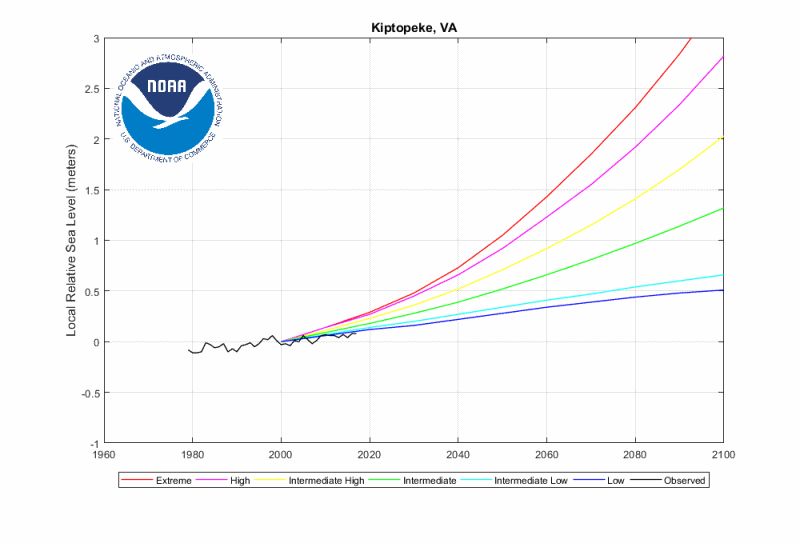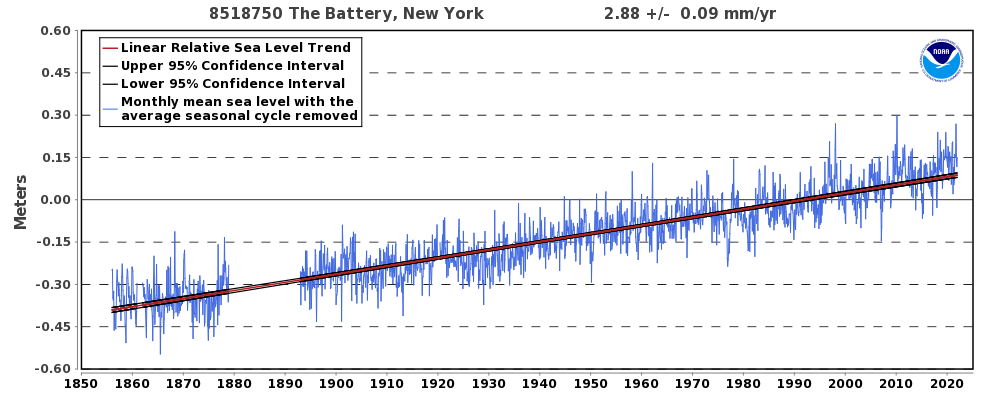Dozens of media outlets are parroting a news release from NASA, the National Oceanic and Atmospheric Administration (NOAA), and other federal agencies. Headlines such as Sea level to rise one foot along U.S. coastlines by 2050, government report finds and Seas could rise up to a foot by 2050, posing ‘a clear and present risk’ to U.S. have been common in the media during the last week.
The February 15 report, titled Global and Regional Sea Level Rise Scenarios for the United States, concludes that sea level along U.S. coastlines will rise between 10 to 12 inches on average above today’s levels by 2050.
The report makes forecasts for sea level rise to the year 2150 and also makes near-term projections for the next 30 years.
But when you examine historical sea level data and analyse the trends, this report falls far short of the projections they claim.
In the press release, they say:
This report supports previous studies and confirms what we have long known: Sea levels are continuing to rise at an alarming rate, endangering communities around the world. Science is indisputable and urgent action is required to mitigate a climate crisis that is well underway,” said NASA Administrator Bill Nelson.
NASA is steadfast in our commitment to protecting our home planet by expanding our monitoring capabilities and continuing to ensure our climate data is not only accessible but understandable.
[The] “Science is indisputable…” Maybe only in the mind a government employee like Bill Nelson, but disputing existing science is a cornerstone of the advancement of scientific knowledge.
The problem is that projections of significant, even catastrophic sea level rise have been made before, and they never happened. The most famous sea level claim came from a United Nations (U.N.) official, published in the Associated Press. As detailed in Climate at a Glance: Climate Refugees, in 1989, a senior U.N. environmental official claimed, “entire nations could be wiped off the face of the Earth by rising sea levels if the global warming trend is not reversed by the year 2000.” Obviously, those nations are still there.
Also, in 2005, the U.N. claimed, “Rising sea levels…will create up to 50 million environmental refugees by the end of the decade.”
Neither of these predictions, both based entirely on computer model projections similar to the most recent report this past week, came true. The refugee projection became such an embarrassment for the U.N., it tried to “disappear” the claim.
So with that kind of track record, why should we believe the latest claims of a foot of sea level rise in the next 30 years? We shouldn’t, and there are two good data-based scientific reasons not too believe the projection.
First, the data we have does not support the claim when you look at observed sea level trends so far. Much of the areas that could be affected by a foot of sea level rise are in the Northeastern U.S. But, an examination of every NOAA tide gauge in the Northeast U.S. show the observed rate of sea level rise is at or below NOAA’s lowest scenario. Watch this animation in Figure 1 that cycles through several cities in the Northeast:

Secondly, to get to the 1 foot of rise predicted, sea level rise would have to accelerate over what has been observed in the data so far. And so far, there’s very little evidence of it.
In Climate at a Glance: Sea Level Rise, we point out that global sea level has been rising at a relatively steady pace of approximately one foot per century since at least the mid-1800s. Coastal cities, such as New York City, have been managing the sea level rise just fine. As shown in Figure 2, New York shows a steady increase since 1856 with no discernable acceleration.

In NOAA’s own words on their website that provides Figure 2 above they say this about the New York City data:
The relative sea level trend is 2.88 millimeters/year with a 95% confidence
interval of +/- 0.09 mm/yr based on monthly mean sea level data from
1856 to 2020 which is equivalent to a change of 0.94 feet in 100 years.
NOAA’s own data doesn’t even support the claim in their most recent report. The data suggests it will take 100 years, not 30, to reach one foot of rise.
There has been very little recent acceleration in sea level rise. Assuming all of the modest increase in sea level rise is due entirely to alleged human-caused global warming, that amounts to an acceleration of only 0.3 inches of sea level rise per decade on top of the preexisting 1.2 inches of sea level rise per decade.
At 1.5 inches per decade, that puts us at 3 decades x 1.5 inches/decade = 4.5 inches
That falls well short of the 12 inches that has been forecast for the next 30 years.
Given the track record of predictions, the observed data, and the disparity of the observed data compared to climate model predictions, there no impending “alarming” crisis of sea level rise, and cities like New York will continue to manage it as they have for over 150 years.

























I can cite about a dozen doomsday climate predictions that never came true.
As usual, Anthony hits all the important points.
w.